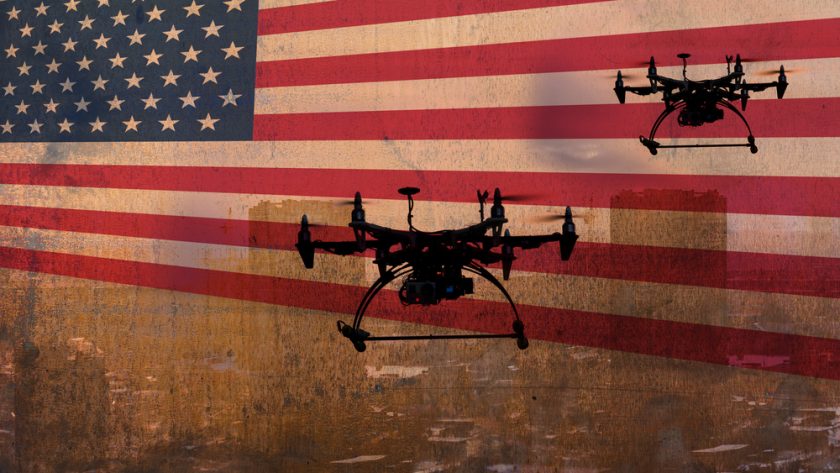Mary-Lou Smulders, Chief Marketing Officer and Head of Government Affairs, Dedrone
Summer is the peak travel season in the US, and 2024 is no exception. Each Thursday in June ranked among the 10 busiest flight days of the entire year, with June 27 setting a record as the single busiest day so far. This year, July 4th also falls on a Thursday, promising crowded skies filled with planes, fireworks, and drones.
In 2023, drone flights on July 4th were 3.6 times higher than the average of all the other days of the year, a trend expected to continue or even increase in 2024. Additionally, historical data from Dedrone shows a consistent annual increase in 4th of July drone activity, with 2022 seeing 1.4 times more drone flights on the Fourth compared to 2021, and 2023 doubling the number from 2022.
This additional activity isn’t simply explained by increasingly-popular drone shows. Last year, 33% of drone flights on July 4th violated FAA regulations, highlighting the risks posed by unregulated drone operations during such a busy period. With the skies busier than ever, it’s crucial for drone pilots to understand the rules and prioritize safety to prevent serious consequences.
Unregulated drone flights pose risks
Last year, there was a significant increase in drones flying above 400 feet, which is illegal and potentially dangerous. Most commercial-grade firework shells used in shows are 6-12 inches in diameter, and a 6-in shell can fly over 600 feet in the air. A drone breaking the 400-ft limit could easily collide with pyrotechnics, potentially causing harm to people nearby.
While it seems like common sense to avoid mixing electronics and explosives, social media shows many drone pilots attempting to capture footage through firework displays, often resulting in damaged or lost drones.
The dangers of flying drones in restricted airspace
In addition to flying over 400 feet, it is also illegal to fly in certain areas that are restricted to drones. These areas often include near airports or around stadiums, national parks and high security areas like Washington DC. Unauthorized drone flights in these areas pose serious risks and could be prosecuted as a felony. On the 4th of July last year, there was a notable (4.3x) increase of drones flying in restricted airspaces when compared to the average of all the other days in 2023.
The most concerning of these restricted type airspace flights are those near airports. Clearly, drones and planes aren’t an ideal combination, but not all drone pilots are aware of how to fly legally. A study of near-misses between crewed aircraft and drones, found that 96% of the events identified featured a drone that was flying too high, and most of them were also close to departure and runway approach routes.
Due to their size difference, pilots of large crewed aircraft don’t always realize that they’ve been hit by a drone, leading to unpredictable damage. Luckily, most collisions between drones and crewed aircraft thus far have not resulted in catastrophic outcomes, but the increasing drone activity raises the likelihood of more severe incidents.
The importance of legal and safe flying
Public safety officials need to both recognize the potential threat and understand current patterns for effective responses. Height restrictions alone are insufficient to protect planes and public gatherings from unauthorized drone fights. Furthermore, even drone shows, which can operate above 400 feet with FAA waivers and often coordinate with fireworks, need to be managed carefully to ensure safety.
Understanding these risks and adhering to legal flight regulations are crucial for ensuring public safety during high-traffic events like Independence Day.
To date, rogue drones haven’t hurt too many people nor even interrupted many drone shows; however, incidents do happen. Drones operating as part of the show swarm have occasionally gone rogue and dropped from the sky. A notable incident in Taiwan had nearly 5% of a show’s drones affected. More concerning, a lone drone trying to capture the show and a show drone responding to its programming could collide, especially if the lone drone’s pilot is operating the drone beyond their visual line of sight (BVLOS) – also a potential felony.
Drone piloting 101 for a safe July Fourth
The increasing popularity of drones across the country adds another layer of complexity to keeping the skies safe on busy holidays like the Fourth of July. Public safety agencies are adopting drone detection, tracking, and identification (DTI) technology, which can alert them to a drone that is not flying safely and help them locate the pilot.
The best way drone pilots can help this Independence Day is by following a few simple rules:
- Don’t fly above 400 feet
- Don’t fly in restricted airspaces like near active stadiums or airports, in national parks, or in heavily-protected areas such as Washington DC
- Don’t fly your drone out of your line of sight
- Don’t fly over people
All of these rules are set by the FAA and the Department of Justice are beginning to charge violators regularly. The drone pilot who interrupted this year’s AFC Championship could be sentenced to up to four years in prison. In Los Angeles, a pilot whose drone hit a police helicopter is also facing a federal complaint. As lawyer Kathryn Rattigan wrote in her assessment of the case, “This case should warn drone pilots everywhere.”
My final message to drone pilots: fly smart and stay safe this Fourth of July. Damaging your drone for exciting footage of fireworks or drone show footage isn’t worth it. Don’t ruin travelers’ holidays by flying around airports. Keep your drone where you can see it, so it doesn’t crash into something else. Law enforcement is watching — and they will prosecute.
In short: fly legally, and you can enjoy the holiday weekend without a hitch.




